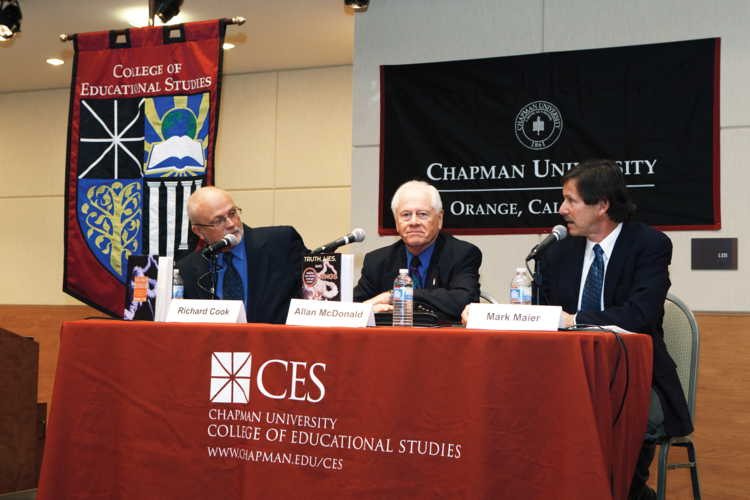By Mitali Shukla
As the second most-viewed NASA launch in its history, the Challenger disaster stands out in history because it could have been prevented.
Netflix released the four-part docuseries “Challenger: The Final Flight” on Sept. 16, investigating the 1986 failure-to-launch of NASA’s “Challenger” space shuttle. The flight garnered global attention because of NASA’s choice to send a civilian – Christa McAuliffe, a social studies teacher – into space. McAuliffe and six other astronauts died in the explosion due to faulty equipment, which was discovered after an investigation into the tragedy.
Chapman Leadership Studies Program Director Mark Maier had close relationships with people directly involved in the Challenger mission, which led him to create a 1992 video-based training module called “A Major Malfunction: The Story Behind the Space Shuttle Challenger Disaster.”
Maier’s connection to the Challenger accident dates back to 1988 during his time as a student at the State University of New York (SUNY), where he met one of the engineers from the mission, Roger Boisjoly.
“Boisjoly was going around for free on college campuses to deal with his own guilt about why he hadn’t done more to stop (NASA) from launching (Challenger), because he felt like the seven people died because he hadn’t been vocal enough,” Maier said. “He had been vocal enough, but the senior managers wouldn’t listen to the experts.”
Maier’s friendships with engineers Boisjoly and Allan McDonald made him a key figure for production companies – Sutter Road Picture Company and J.J. Abrams’ Bad Robot – to contact for the Netflix series.
“I researched (the Challenger) for five years and had a treasure trove of materials from NASA,” Maier said. “It was a labor of love – I was really representing Roger Boisjoly’s story. (The production companies) had access early on to the documentary I produced, so that helped them shape and frame the documentary that they made.”
Annie Tang, coordinator of special collections and archives at Chapman’s Leatherby Libraries, collaborated with Maier to provide the series’ producers with three “Challenger” special collections that contained documents and photographs from the investigation following the deadly explosion.
“Long story short, the crash happened because of equipment that was known to become faulty in extreme cold weather conditions, and it was very cold the day of the launch,” Tang said. “NASA knew prior that there was a small chance of equipment going faulty, but they took the advice of the company that built the equipment, Morton Thiokol.”
Tang warned viewers that “Challenger: The Final Flight” is no easy watch.
“You’re watching a train wreck in slow motion, and you know it’s going to happen,” Tang said. “Even if you have no idea what the history is, you are told what happens in the first five minutes, meaning the rest of the four episodes are a very emotional watch. It was beautifully done, and it honored the people that passed away.”
Despite Maier and Tang’s praise, Maier noted Boisjoly was not mentioned in the series nor did the producers of the documentary point to the pressure from not only a global audience, but then-President Ronald Reagan’s reelection campaign, in reference to the explosion.
“The Challenger flight was the 25th flight of the space shuttle program, and had more public interest than every single NASA flight in history except one: the first moon landing,” Maier said. “But this teacher-in-space mission was the second-most widely watched flight in NASA history, with all the attention of the world on it. It was the first time in the entire history of space flight that a contractor ever told NASA that they weren’t ready to fly. None of that is mentioned in the documentary.”
Maier’s background in sociology framed his perspective on the Challenger mission. What he saw unfolding was an abuse of power by people in an authoritarian structure – one he asserted was misogynistic, as men largely ignored the advice of women experts in their decision to press forward.
“They didn’t probe the open questions about why there was so much pressure to get the teacher up in space on that particular day. I thought the documentary would be a definitive, final word on Challenger, but sadly it’s not true,” Maier said. “It does add some additional layers of understanding to the saga for us, but it still leaves some of the major questions unresolved.”
Maier drew parallels in leadership between the decisions on the Challenger mission and the coronavirus, emphasizing how scientific discoveries have been politicized despite experts advising the public on the appropriate course of action. Instead of listening to those experts, NASA chose not to upset Morton Thiokol – as Tang mentioned, the company that built the faulty equipment – silencing the engineers who spoke out against the launch and pushed ahead with their agenda.
“Follow the science. You may not like what the science (insinuates), but you’re supposed to listen to your experts,” Maier said. “If you keep handing out the same script, you’re going to keep getting the same outcome: people will launch Challengers every day.”

